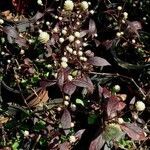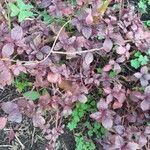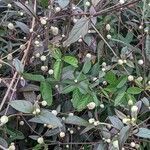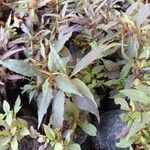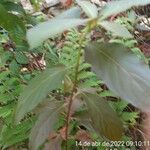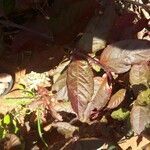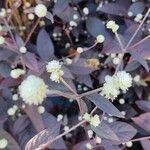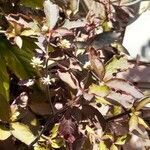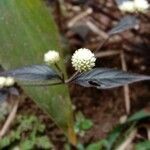Perennial herb to 1.5(-2) m, sometimes vining (scandent), scrambling or fruticose; stems erect, spreading, with swollen, purple nodes; stems and young leaves densely appressed-tawny-pubescent. Petiole less than 1 cm long; blade elliptical, lanceolate or ovate, acuminate at apex, cuneate to rounded at base, 5-12.5 x 1.5-4.7 cm, green (reddish-purple in cultivar ‘Rubiginosa’, see note). Inflorescence axillary or terminal, 2-16 cm long pedunculate heads (rarely with a smaller, sessile head in addition to long-pedunculate ones); heads of numerous flowers, hemispherical and to 1 cm long, to conical and to 2.5 cm long, or shortly cylindrical; pedicels minute; bracts ovate to lance-acuminate, mucronate, hyaline, 1-veined, 2.8-4 mm long; bracteoles conduplicate, lanceolate, 4-5.1 mm long, acute, apiculate, serrulate, with stramineous, denticulate margin, pubescent on upper half of back, longer than tepals, with a prominently raised central vein along fold, enclosing tepals. Tepals, white, with hyaline, stramineous margin, narrowly lanceolate, 3.0-4.3 mm long, acute, apiculate, entire, 3-veined, appressed-puberulent on back in a line on the middle; stamens 5, anthers oblong, pseudostaminodia exceeding stamens, ligulate, apically incised or dentate; stigma capitate. Utricle oblong, 2.1 mm long; seeds deep red or brown, cylindrical or subglobose, 1.6-1.8 mm long, shining.
Herbs or subshrubs, annual or perennial, 5-6 dm. Stems erect, villous, glabrate. Leaves sessile; blade ovate to lanceolate, 1-7 × 0.7-1 cm, herbaceous, villous. Inflorescences terminal and axillary, pedunculate; heads white, globose, 0.7-1 cm diam.; bracts keeled, shorter than to equaling tepals. Flowers: tepals monomorphic, green to stramineous, lanceolate, 3-4 mm, apex acuminate, villous, hairs not barbed; stamens 5; pseudostaminodes ligulate, margins fimbriate. Utricles included within tepals, brown, ellipsoid, 2 mm, apex acute. Seeds ovoid-oblong, 1.4 mm.
A herb. It grows about 60-150 cm high. It is branched. It has swollen nodes. Young leaves are hairy. The leaves are oval to sword shaped and 5-12.5 cm long by 1.5-4.7 cm wide. The leaves can be red. The flowers are in a group at the top of the plant. These are 2-16 cm long. The flowers are in heads 1 cm long. The seeds are red or brown.
